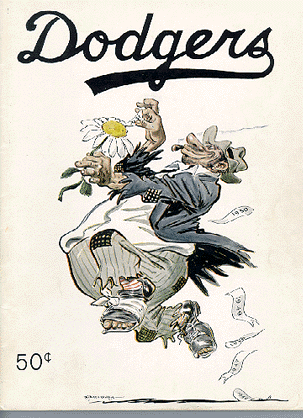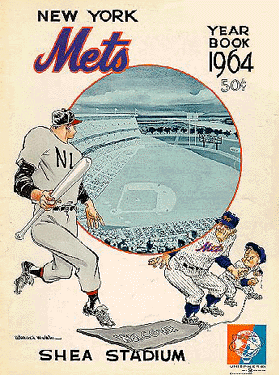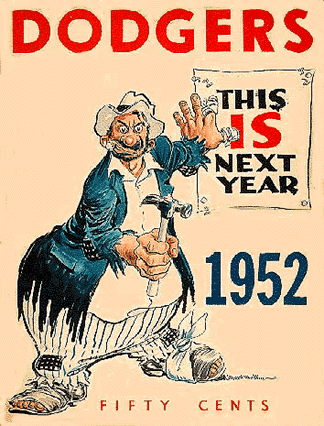Skip to comments.
The Bum and Willard
New York World-Telegram
| 13 November 1953
| Joe Williams
Posted on 03/17/2002 3:40:57 PM PST by BluesDuke
Rebecca A. Brady, 714 E. Fifth St., Brooklyn, writes:
For years you have been using the derogatory term, "The Bums," in poisonous contrast to the inspiring, "The Bronx Bombers" for the Yankees. It is shuddering just to think of the pitiful contrast in connotations.
In this age when we all know something about psychology, we should realise people respond to the name they are called. If you have children you would not call them "Bums" if you expected them to amount to anything.
Every once in awhile a protest of this nature arrives in the mail, but this is the first time it has been used to explain the Brooklyns' endless futility against the Yankees in the World Series. Wondering how Walter O'Malley, the president of the club, felt about the matter, I solicited his views. O'Malley answered by return mail:
Although your correspondent professes not to be interested in the origin of the term, for historical purposes it should be noted "The Bums" is a brain child of your Willard Mullin.
The Dodgers, you know, are not just a baseball team. They mean something to people who have never seen a game. The Dodgers are the symbol of the underdog, and well - so is The Bum. The exhortation, "Come on, you Bums," is not an opprobrium. Rather, it is an endearment.
Something of this quality if mirrored in the face of Mullin's character. There are signs of pain and turmoil in his features, on occasions, unhappily, bruises and contusions, and, of course, he is in tatters: but always in his eyes is a look of bold defiance and prideful resolution. At the same time he is not without guile and often these noble aspects are masked by a sly, mischievious twinkle not unlike that which is to be seen in a disdainful urchin's eye as he cocks his rebellions arm to fling a brickbat at a silk hat.
No, I cannot lend myself to any squeamish campaign which has as its objective the demise of The Bum. So far as we in Brooklyn are concerned, the fellow is here to stay.
You will note O'Malley indicates The Bum has a contract for life. This implies a position of preeminence without contemporary parallel, for no other individual in the Brooklyn organisation, from top executive to bullpen catcher, has a contract that calls for more than one year.
To be sure, The Bum does enjoy certain advantages which set him apart. One look at his unkempt beard and disreputable clothes is enough to suggest that he is not exactly the highest-paid man on O'Malley's salary list. And apparently, the only time he eats is when Mullin feeds him.
It may be, too, that The Bum owes his unique security to the fact that he has no wife. Anyway, there's no record she ever wrote O'Malley a letter telling him off, as Mrs. Dressen did.
TOPICS: Arts/Photography; Books/Literature; History; Humor; Sports
KEYWORDS: baseball; baseballlist; brooklyndodgers; cartooning; historylist; joewilliams; sportswriting; walteromalley; willardmullin
Until I found this, in an out-of-print collection of old-time New York sports columnist Joe Williams's writings, I had never known of Walter O'Malley - to this day there remain plenty in New York and in Brooklyn especially who deem him the Great Satan - writing this much, from a kind of metaphysical perspective, about what his team and the cartoon character in particular symbolised. Considering the stereotype of O'Malley as the ruthless, avaricious bastard who just picked up his toys and ran away from home, after New York refused to just build a new ballpark and
give it to him (this stereotype, without nominating O'Malley for sainthood, is patently false), it is rather a revelation.
The cartoonist in question, who created the popular image of the Brooklyn Bum, was Willard Mullin, also of the old
New York World Telegram, and perhaps the finest sports cartoonist of them all. I know otherwise, of course, but a piece of me prefers to think that sports cartooning became a dying art in American newspapers because, when Willard Mullin finally retired, newspaper editors realised sadly enough that they could never improve on perfection.
Here is one of Mr. Mullin's typical illustrations, which was actually the cover of the 1951 Brooklyn Dodgers' yearbook:

Here is a classic Mullin, the cover of the 1964 New York Mets yearbook. (Mullin's cartoons during the Mets' early seasons were just as classic as in the days of the Dodger-Giant-Yankee rivalries, and in fact Mullin did Met yearbook covers until the early 1970s.):

Click on either cartoon to see a charming site devoted to the man and his art.

(The allusion to "Mrs. Dressen," by the way, refers to Dodger manager Charley Dressen's wife writing O'Malley a very testy letter in which she made even more vociferous a demand for a multi-year contract than her husband had done. When Dressen insisted on the three-year deal only by saying "My wife and I got to have security," O'Malley - who held strictly to single-year contracts, after a few instances of the Dodgers canning managers before multiyear deals expired, meaning they still had to pay those deals - released Dressen, who went on to manage the minor-league Oakland Oaks, the major league Washington "First in war, first in peace, and last in the American League" Senators, and Detroit Tigers, the latter a job he held until his death in 1966.)
1
posted on
03/17/2002 3:40:57 PM PST
by
BluesDuke
To: BluesDuke
More on the Brooklyn Bum phenomenon
here.
2
posted on
03/17/2002 5:21:08 PM PST
by
NYCVirago
To: NYCVirago
I remember seeing a picture of smiling old Walter O'Malley himself holding up that Daily News headline. Mr. Hinckley, however, needs to have his history straightened out on one small detail: the infamous Bill Terry wisecrack, "Is Brooklyn still in the league?", was pulled before the 1934 season, not the 1937 season. And, as it happened, Dem Bums (with Casey Stengel himself as their manager), mired otherwise in sixth place, finished the 1934 season by blasting the Giants right out of the pennant by sweeping two on the final weekend at the Polo Grounds, including a nail-driving game by star Dodger pitcher (you've got to love this name) Van Lingle Mungo - with throngs of Dodger fans screaming and holding of wisenheimer bedsheet banners as would become even more the custom when the Mets opened for business (the banners were a one-time thing, apparently, for the Dodger fans) - while the St. Louis Cardinals' Gas House Gang beat the Cincinnati Reds twice to clinch it. The Giants and the Cardinals had gone into that final weekend in a dead heat for first place, but then it was, as one of those Dodger fan banners had it, "Is Brooklyn still in the league? And How!"
Incidentally, it was Willard Mullin himself who was also responsible for the Cardinals earning the nickname the Gas House Gang in the first place: after a rather roughly-played series with the Giants, Mullin seized upon the Cardinals' gritty playing style and depicted them coming out of a shack on the wrong side of the tracks with a huge gas tank on the grounds, carrying their bats on their shoulders like union headknockers, and the image and the nickname stuck - to the delight of the Cardinals, whose shortstop Leo Durocher passed a remark about how the American League would think of them ("They'd probably think we were gas house ballplayers") that kicked off Mullin's cartoon fancy.
Customarily, though, Willard Mullin's character to represent the St. Louis Cardinals was a slick looking gambler type known as St. Louis Swifty. He drew a dark, gritty Indian with tomahawk to depict the Boston Braves (who took on a German accent and traded tomahawk for beer stein when the team moved to Milwaukee), a big dumb oaf to represent the New York Giants, po' white trash with a jug of corn squeezin's (thank you, Red Smith!) to represent the St. Louis Browns...Willard Mullin was one of a kind. When the Mets first came into operation, Mullin's image for them was an infant in a diaper, spiked shoes, and Mets cap, though in their second season he put the little fellow in a pinstriped Mets jumper (with the panel in the rear end, yes!)...
3
posted on
03/17/2002 6:06:25 PM PST
by
BluesDuke
To: NYCVirago
Hickley was also wrong about Willard Mullin's Bum "losing work" after the Dodgers went west. When the Mets came around, Mullin did indeed revive the Bum to represent the Dodgers, complete with sunglasses every once in awhile. One of his best cartoons in that era was a two-parter, in which the little Met was depicted hiding under the bed, peeking out from the darkness beneath the blanker, with the Bum lifting the blanket saying, almost comfortingly, "I know some people aren't afeared of me..."; then, in part two, Mullin writes, "The Mets had lost...and then what did they do? They went out and walked all over the league-leading Dodgers..in L.A....at night!" Beneath that, the Bum is flat on his back with the little Met sleepwalking over his front.
Mullin also drew an unforgettable front-page cartoon for Newsday, after the Miracle Mets won the 1969 World Series: the little Met is swinging madly and knocking all the other Mullin team symbols all over the place - including the Bum, flipping over with his legs in the air and his fat can bottom-down - saying, "Y'mean this is all there was to it all along?" An interesting image, especially considering the Mets' surreal Series win was as much a product of their stellar pitching and their acrobatic defencive work as their hitting...
4
posted on
03/17/2002 6:18:44 PM PST
by
BluesDuke
To: NYCVirago
5
posted on
03/17/2002 6:27:44 PM PST
by
BluesDuke
To: BluesDuke
I am not surprised to find out that David Hinckley was wrong at least twice in that article. He did one of those "big town character" articles about Tony Manero of "Saturday Night Fever," and said that the movie was released in the summer of 1978 (it was released in the winter of 1977; the reason I remember that is because it came out a good six months before "Grease," another John Travolta hit movie.) Hinkcley also said that Manero lived in Bensonhurst, when his neighborhood was Bay Ridge, the Brooklyn neighborhood closest to the Verrazano-Narrows Bridge (if you remember, the bridge played an important part in the movie.)
6
posted on
03/17/2002 6:48:33 PM PST
by
NYCVirago
To: NYCVirago
I sure do remember the Verazzano Bridge scenes in Saturday Night Fever. Don't they have a fact checker at the News? Or doesn't Hinckley bother to check his dates as best he can? Next he'll try to tell us that Ebbets Field was demolished the moment the Dodgers left town. (The park came down at last in 1960, by the way - and the same baseball-painted wrecking ball was used to bring down the Polo Grounds in April 1964.) I'm writing a book about the 1962 Mets (almost ready to make a formal proposal to agents/publishers, by the way - three draft chapters done) and I've checked and double checked multiple sources already to check dates when I use them specifically. It doesn't take that much effort.
7
posted on
03/17/2002 6:56:19 PM PST
by
BluesDuke
Comment #8 Removed by Moderator
To: BluesDuke
I don't know where the fact checkers are on these things. Case in point -- I just finished reading "Basket Case," which is Carl Hiassen's new book. It's a pretty good read, but I was astonished by one glaring error in it. The story is about a 46-year-old obituary writer who is obsessed with death, and he keeps on saying that Elvis and JFK died at age 46. Well, that was true about JFK, but Elvis was only 42 when he died! I was hoping that there was going to be a payoff to this repeated error in the narrative, but no such luck.
9
posted on
03/17/2002 7:21:09 PM PST
by
NYCVirago
To: NYCVirago
I hope the payoff comes soon and doesn't jinx me, since I am 46 even as I speak. On the other hand, I seem to remember Hoyt Wilhelm pitching when he was 46, so why should I worry?
Disclaimer:
Opinions posted on Free Republic are those of the individual
posters and do not necessarily represent the opinion of Free Republic or its
management. All materials posted herein are protected by copyright law and the
exemption for fair use of copyrighted works.
FreeRepublic.com is powered by software copyright 2000-2008 John Robinson



